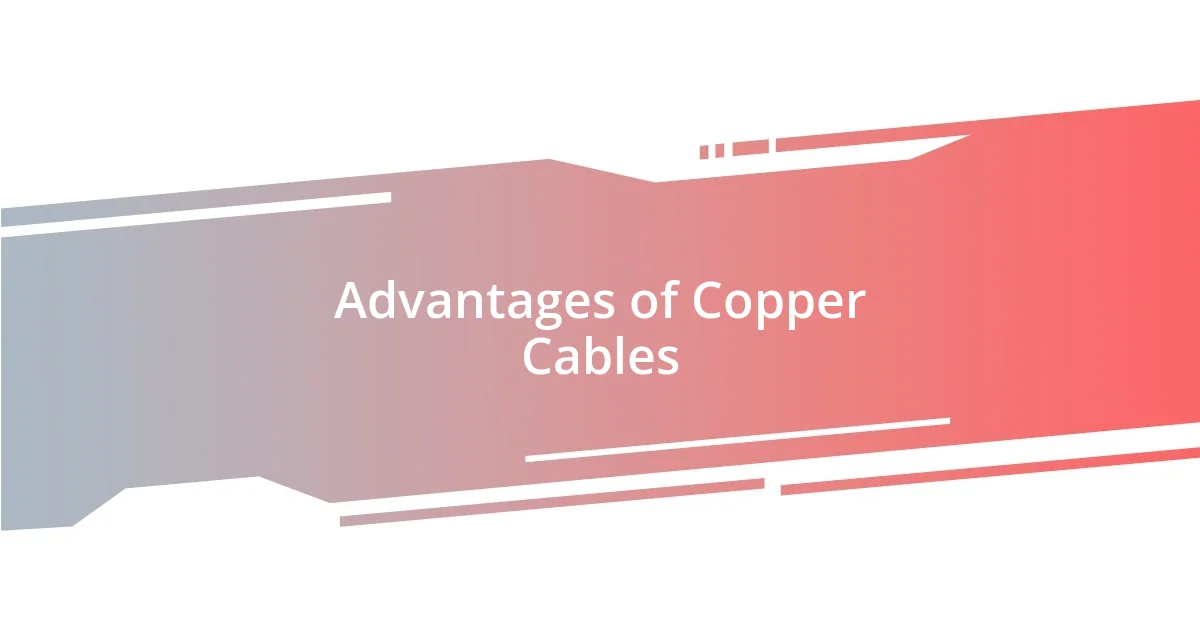Key takeaways:
- Fiber optic cables provide significantly faster speeds and greater bandwidth compared to copper, making them ideal for high-demand applications.
- Copper cables are more affordable and easier to install, making them a suitable option for budget-conscious users or smaller setups.
- Both cable types have unique advantages: fiber excels in speed and distance, while copper offers reliability and practical ease of use in less demanding environments.

Introduction to Cable Types
When I first delved into the world of cable types, I was struck by how fundamentally different they are yet how crucial each type is for our connectivity needs. From my experience, understanding these differences can save us both time and money when setting up a network. Have you ever had to troubleshoot a connectivity issue only to realize it was a simple oversight in cable selection?
Fiber optic cables, with their high-speed capabilities, fascinated me right away. I remember the first time I experienced fiber optics—it was like switching from a bicycle to a sports car in terms of internet speed. On the other hand, copper cables, while seemingly outdated to some, have their own charm and reliability that many still appreciate today. It makes me think: is it nostalgia or just solid performance that keeps people loyal to copper?
As technology evolves, so do the choices we face. I’ve seen businesses making decisions that profoundly impact their operations based on the type of cable they choose. This makes it essential to weigh the unique benefits of each option carefully. So, what’s your priority—speed, reliability, or maybe cost? Understanding what each cable type brings to the table can help you make that choice confidently.

Understanding Fiber Cables
Fiber optic cables utilize light to transmit data, enabling astonishing speed and bandwidth that can leave traditional copper cables in the dust. The first time I set up a fiber connection for a friend’s business, I was amazed how the data flew through the network. There’s something exhilarating about watching the lights pulse through a fiber line, knowing they carry a wealth of information at lightning speed.
Here are some key features of fiber cables:
- Speed: Fiber cables can transmit data at speeds exceeding 1 Gbps, offering a major advantage for high-demand environments.
- Distance: They can carry signals over much greater distances than copper without degrading performance, often up to several kilometers.
- Bandwidth: Fiber cables support significantly higher bandwidths, making them ideal for data-heavy applications like streaming and online gaming.
- Interference Resistance: Unlike copper, fiber cables are immune to electromagnetic interference, ensuring a more stable connection.
- Security: Fiber optic communication is harder to tap into, providing a more secure option for sensitive data transmissions.
Just thinking about these advantages makes mereflect on how transformative fiber optics can be for a community. Imagine a small town that upgrades its internet infrastructure to fiber. The possibilities for remote work, online education, and even telehealth services could flourish, enhancing quality of life in ways we’re only beginning to recognize.

Advantages of Fiber Cables
Fiber cables truly stand out for several reasons. For one, they deliver exceptional speed that can sometimes feel like teleporting data across networks. I often think back to when I was setting up a home office. Switching from copper to fiber was a game changer; downloads that once seemed painfully slow became instantaneous. It felt like finally unlocking a door that let me step into the future of connectivity.
Another remarkable aspect of fiber cables is their impressive distance capabilities. I remember helping a relative expand their business network to multiple floors in a high-rise building. Fiber made it so seamless—no need to worry about signal loss over long distances. Knowing that they could communicate effortlessly across several floors meant a lot, especially for coordination among teams.
Additionally, the immunity to electromagnetic interference might sound technical, but it has real-world benefits. Often, I’ve been in crowded office settings where people working with copper cables would frequently experience connectivity issues. It’s frustrating! When I switched to fiber for a shared workspace, it was like a breath of fresh air. Everyone was able to link up without interruptions, fostering a collaborative environment.
| Advantage | Description |
|---|---|
| Speed | Data transmission speeds exceeding 1 Gbps. |
| Distance | Maintains performance over longer distances than copper. |
| Bandwidth | Supports higher bandwidth for data-heavy applications. |
| Interference Resistance | Immunity to electromagnetic interference enhances stability. |
| Security | More secure for sensitive data with limited tapping risks. |

Understanding Copper Cables
Copper cables have long been a staple in our communication infrastructure. I remember the days when I first wired my home for internet using coaxial and twisted pair cables; there was a sense of accomplishment as I laid those cables down. It’s fascinating how we often take these metallic connections for granted, especially considering their role in transmitting everything from television signals to internet data.
One thing that stands out to me about copper cables is their ability to handle electrical signals with relative ease. However, they are limited in distance and susceptible to interference. I’ve had experiences where my wired connection would suddenly drop during a storm or when a nearby microwave was in use. It’s moments like those that make you appreciate how environmental factors can affect connectivity, often leading to frustrating downtime.
Despite these challenges, copper cables remain a valuable option for shorter connections, like within our homes or small offices. I vividly recall the time I helped a friend set up a local network in their startup. Using copper cables for that purpose felt reassuring; they were budget-friendly and delivered satisfactory speeds for their needs. It was a simple yet effective solution that got them up and running quickly, proving that even older technology has its place in our rapidly evolving digital world.

Advantages of Copper Cables
Copper cables have several advantages that make them an appealing choice for many setups. For instance, one thing I appreciate is the affordability of copper cables. When I was upgrading my home office, I opted for a copper setup initially because I was on a budget. It not only met my immediate needs but also gave me the flexibility to later transition to more advanced solutions like fiber as my requirements grew.
I find the ease of installation to be another strong point. Unlike fiber cables, which can sometimes require specialized skills and tools, working with copper is relatively straightforward. I still remember the DIY project where I painstakingly crimped connectors onto twisted pair cables; it took some trial and error, but the satisfaction of seeing it all come together was worth it. Have you ever tackled a tech project on your own? There’s something incredibly fulfilling about it!
Then there’s the reliability factor. Copper cables, especially in well-built environments, can provide a stable connection for everyday use. I recall a time when my neighbor faced ongoing connectivity problems with their fiber setup during harsh weather. Meanwhile, my trusty copper cable network held strong. It made me realize that sometimes, the old-school options can stand the test of time despite the allure of newer technologies. It’s a reminder that being grounded in the basics can serve us well in many situations.

Comparing Fiber and Copper
When comparing fiber and copper cables, it’s fascinating to see how each technology offers unique advantages and limitations. I remember being at a tech conference where a speaker passionately described the speed of fiber optics, which can reach up to a staggering 1 Gbps over considerable distances. It really struck me how fiber can transmit data without the interference that copper often faces, making it the clear choice for high-demand environments like data centers. Have you ever wondered how much faster our streaming and gaming experiences could be on fiber?
On the flip side, copper still holds its ground in many situations. For example, I once used copper cables to set up a quick Wi-Fi extender for a friend who lived in a less tech-savvy neighborhood. The beauty of that setup was how simple and low-cost it was. Sure, we might have lost a bit in speed, but for everyday usage—like browsing and casual streaming—it worked perfectly fine. There’s a kind of reassurance in knowing that, though slower, copper can still do the job when life’s not too demanding.
Moreover, the actual physical aspect of working with these cables is worth considering. I recall a time when I had to fish a fiber optic cable through the walls of my home. It was definitely a challenge; the fragility of the glass fiber meant I had to be extra careful. In contrast, I find myself reminiscing about the robustness of copper when I accidentally dropped those cables during installation and they bounced right back without a scratch. It made me think: Does reliability in handling and installation play into your choice of cables too? For many, those practicalities often tip the scales in favor of copper in everyday scenarios.















